A new report from the University of Wyoming (UW) paints a mixed economic outlook for the state in 2025, with both opportunities and challenges on the horizon.
The report, issued by the Center for Business and Economic Analysis in UW’s College of Business, was released in conjunction with the Governor’s Business Forum, currently taking place on the UW campus at the Marian H. Rochelle Gateway Center.
The second annual Wyoming Economic Forecast highlights several key factors that will shape the state’s economy in the coming year. While some areas show promise for growth, others present significant hurdles that could impact Wyoming’s mid- and long-term economic prospects.
According to the report, Wyoming’s economy is expected to see slight overall growth in 2025, with a small increase in employment and a minor uptick in the state’s population. However, the state faces ongoing challenges that will need to be addressed to unlock its full economic potential.
Key areas of opportunity identified in the report include:
- Growth in Employment: Employment in natural resources and mining is expected to rise modestly, alongside increases in sectors such as wholesale trade, construction, manufacturing, retail trade, transportation, utilities, and financial services.
- Business Development: Wyoming is seeing strong numbers in business startups, with a 25 percent increase in new business applications between September 2023 and September 2024. The state also ranks highly in science and engineering degrees awarded, and its venture capital disbursement per $1 million in gross state product is among the highest in the nation.
- Innovation and Patents: The state has seen a significant increase in the number of patents, especially in science and engineering fields. With 15.18 patents per 1,000 individuals in science and engineering occupations, Wyoming is well above historical averages.
- Entrepreneurship: Wyoming was recently ranked as the sixth-most entrepreneurial state in the nation, a positive sign for future economic resilience.
Despite these positive indicators, several factors could hinder the state’s economic growth.
The report also highlights a number of challenges that could limit Wyoming’s growth prospects:
- Housing and Child Care Shortages: The state continues to face a significant shortage of affordable housing, which is a key barrier to attracting and retaining workers. Additionally, a lack of accessible child care options is making it harder for families to balance work and life.
- Aging Population: One of the most pressing issues for Wyoming’s future is its aging population. The state’s demographic profile is shifting, with growth driven primarily by individuals aged 45 and older. The populations of younger age groups, including those between 0-4, 5-19, 20-24, and 25-44, are expected to decline. This shift will have broad implications, including a decrease in the workforce necessary to drive economic growth.
- Brain Drain: The state continues to see an outmigration of college-educated young people. Currently, about 37 percent of University of Wyoming alumni from 2007 to 2024 still live in the state, a figure that the report suggests could impact the availability of skilled workers and entrepreneurs in the future.
- Transportation and Connectivity Issues: Wyoming faces challenges related to transportation, including winter road closures and limited airline service, which could impede business mobility and market access. The report also notes that 18.5 percent of Wyoming locations are currently unserved by broadband internet, limiting access to essential services and hindering business growth in some areas.
- Property and Tax Concerns: Rising property values are impacting homeowners, despite Wyoming’s low residential property tax rates. These increases are adding financial strain to households, which could affect consumer spending and economic stability.
While Wyoming’s economic forecast for 2025 presents a mix of opportunities and challenges, the state’s future will depend on how well it can address its current constraints—especially housing affordability, child care, and infrastructure needs. Additionally, attracting and retaining younger, educated workers will be key to ensuring sustained economic growth and development in the coming years.
The report concludes with a call for policymakers and business leaders to collaborate on solutions that can overcome these barriers and capitalize on Wyoming’s strengths in innovation, entrepreneurship, and natural resources.
Sheridan Media and Wyoming Tribune Eagle contributed to this report.









